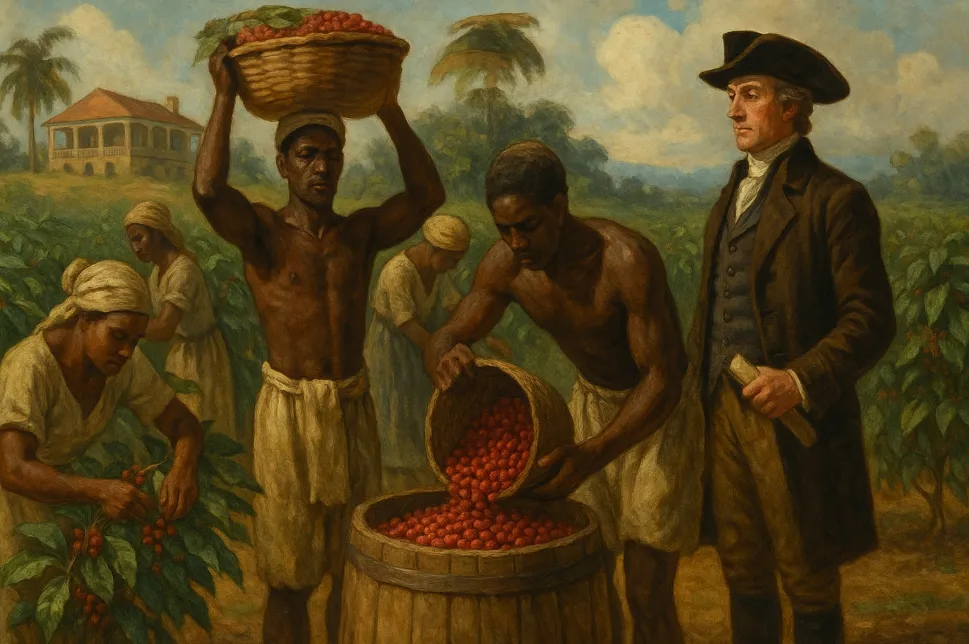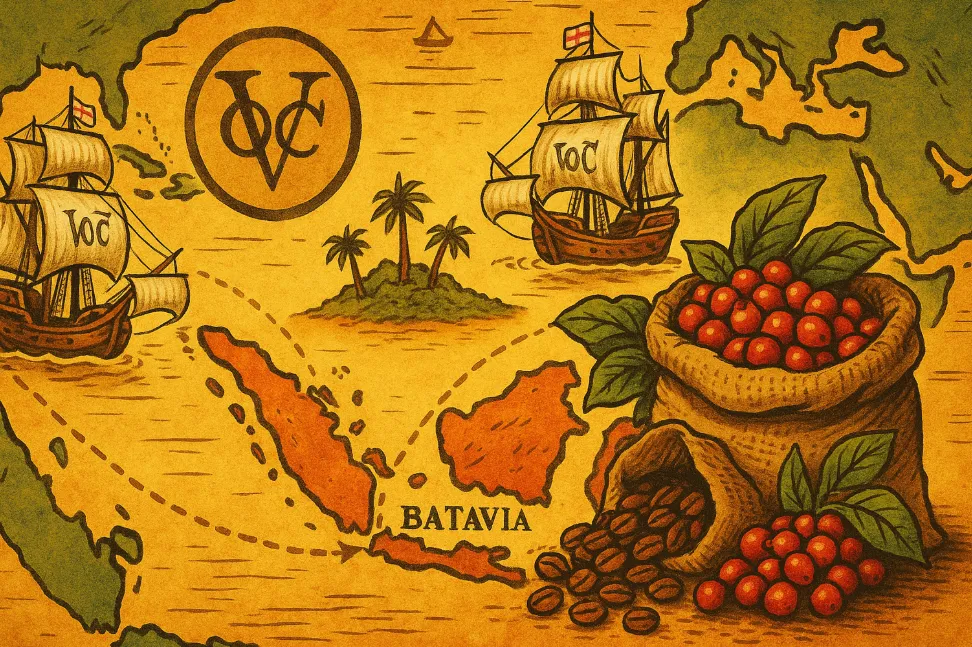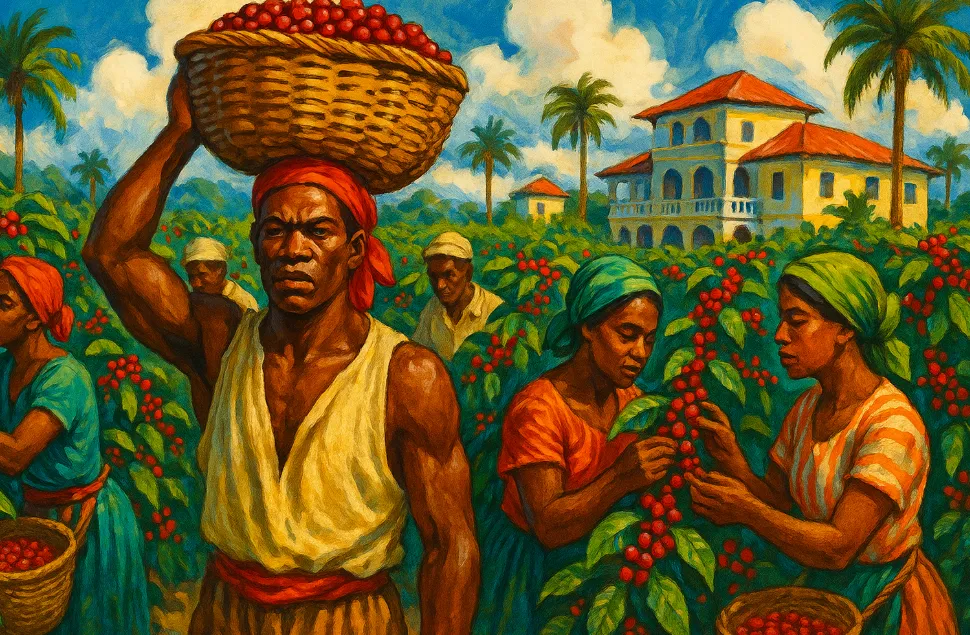Colonialism and Coffee: How European Powers Shaped Global Coffee Production
Explore the complex relationship between colonialism and coffee production. Learn how European colonial powers established coffee plantations, controlled trade routes, and created lasting impacts on coffee-producing regions that persist today.
- Coffee Basics Nerds
- 8 min read

Colonialism and Coffee: The Dark History Behind Your Morning Cup
The coffee trade history is inseparable from the story of European colonialism. What began with Kaldi’s legendary discovery in Ethiopia and spread through Ottoman trade routes to European coffee houses became a global commodity through colonial exploitation, forced labor, and economic control that continues to shape the coffee industry today.
Understanding coffee and colonialism reveals both the human cost of coffee’s global expansion and the ongoing challenges facing coffee-producing nations in achieving economic equity and sustainable production.

The Colonial Coffee Revolution: From Trade to Control
While Europeans initially encountered coffee through Ottoman trade connections, they quickly recognized that controlling production would yield far greater profits than simply importing from Middle Eastern sources.
The Transition from Import to Production Control
European colonial powers shifted strategy:
- Import dependence: Initially relying on Ottoman and Arabian coffee supplies
- Price vulnerability: High costs and supply uncertainty motivated change
- Production control: Establishing colonial plantations to guarantee supply
- Trade monopolization: Eliminating competition through exclusive cultivation rights
This transformation fundamentally changed coffee from a regional specialty to a global colonial commodity.
European Colonial Powers and Their Coffee Empires
The Dutch: Pioneers of Colonial Coffee Cultivation

Dutch East India Company coffee operations established the template for colonial coffee production:
Java Coffee Empire (1696-1800s):
- Seed acquisition: Dutch obtained coffee plants from Yemen in 1696
- Forced cultivation: Javanese farmers required to grow coffee instead of food crops
- Export monopoly: All coffee shipped exclusively to Amsterdam
- Price control: Dutch set artificially low prices paid to local growers
- Infrastructure development: Ports and processing facilities built to support trade
Expansion Strategy:
- Ceylon (Sri Lanka): Coffee cultivation expanded beyond Java
- Suriname: South American plantation establishment
- Caribbean islands: Multiple island coffee operations
- Global network: Coordinated production across Dutch territories
The French: Caribbean Coffee Domination
French colonial coffee development:
Martinique Foundation (1720s):
- Plant introduction: Coffee brought from Java via European botanical networks
- Plantation system: Large-scale cultivation using enslaved labor
- Sugar integration: Coffee grown alongside sugar cane operations
- Processing innovation: French developed improved coffee processing techniques
Haiti Expansion:
- Massive production: Became world’s largest coffee producer by 1790s
- Slave labor dependency: Economy built on brutal forced labor system
- Revolutionary impact: Haitian Revolution (1791) disrupted global coffee supply
- Economic transformation: Independence changed global coffee trade dynamics
The British: Diversified Coffee Colonialism
British colonial coffee strategy:
Ceylon Coffee Boom (1825-1870s):
- Plantation establishment: British developed extensive highland coffee estates
- Labor importation: Tamil workers brought from India for coffee cultivation
- Disease disaster: Coffee leaf rust destroyed industry in 1870s
- Tea transition: Failed coffee operations converted to tea production
Jamaica Blue Mountain:
- Premium positioning: High-altitude cultivation for quality coffee
- Sustained production: Long-term coffee cultivation continuing today
- Economic model: Coffee as supplementary colonial revenue source
The Portuguese: Brazilian Coffee Foundation
Portuguese Brazil coffee development:
- Introduction timing: Coffee brought to Brazil in 1720s
- Gradual expansion: Slow initial growth followed by massive expansion
- Slave labor system: Extensive use of African forced labor
- Independent growth: Brazil eventually became dominant global producer
The Mechanics of Colonial Coffee Control
Establishing Coffee Monocultures

Coffee monoculture history shows how colonial powers prioritized short-term profits over sustainable agriculture:
Monoculture Implementation:
- Land seizure: Indigenous lands converted to coffee-only cultivation
- Food crop displacement: Traditional subsistence farming eliminated
- Ecological disruption: Biodiversity destroyed for single-crop efficiency
- Economic dependency: Local populations forced to rely on cash crop income
Environmental Consequences:
- Soil depletion: Intensive single-crop farming exhausted soil nutrients
- Deforestation: Natural forests cleared for coffee plantation expansion
- Water system disruption: Intensive cultivation affected local water supplies
- Pest vulnerability: Monocultures susceptible to disease and pest outbreaks
Forced Labor Systems in Coffee Production
Colonial coffee plantation operations depended on various forms of forced labor:
Slavery in the Americas:
- African slave trade: Millions enslaved for coffee plantation labor
- Brutal conditions: Extremely high mortality rates in coffee regions
- Economic foundation: Slave labor made coffee profitable for European markets
- Intergenerational trauma: Effects lasting long after slavery abolition
Indentured Labor in Asia:
- Contract labor: Workers bound to plantations through debt systems
- Limited freedom: Movement and employment restricted by colonial authorities
- Low wages: Compensation insufficient for basic survival needs
- Cultural displacement: Workers often separated from traditional communities
Mercantile Control and Trade Monopolies
Colonial trade structure:
Exclusive Trading Rights:
- Royal charters: European companies granted exclusive colonial trade rights
- Competition elimination: Local and competing European traders excluded
- Price manipulation: Colonial powers set both purchase and sale prices
- Market control: European markets protected from direct colonial competition
Infrastructure Development:
- Port cities: Colonial powers developed strategic trading posts
- Transportation networks: Roads and shipping routes built for coffee export
- Processing facilities: Coffee preparation centered in colonial ports
- Financial systems: Banking and credit structures favoring colonial trade
The Human Cost of Colonial Coffee
Indigenous Population Impact
Effects on native populations:
- Land dispossession: Traditional territories converted to coffee plantations
- Cultural disruption: Traditional agricultural practices eliminated
- Forced labor: Indigenous people compelled to work coffee plantations
- Population decline: Disease and exploitation reduced indigenous populations
- Economic marginalization: Excluded from coffee profits despite providing labor
African Diaspora and Coffee
Slavery’s central role:
- Forced migration: Millions of Africans transported for coffee labor
- Cultural preservation: African agricultural knowledge applied to coffee cultivation
- Resistance movements: Slave rebellions disrupted coffee production
- Lasting demographics: African-descended populations in major coffee regions
- Economic exclusion: Post-slavery discrimination continued economic marginalization
Regional Economic Distortion
Long-term economic effects:
- Export dependency: Coffee regions economically dependent on single crop
- Price vulnerability: Local economies subject to global coffee price fluctuations
- Limited industrialization: Colonies kept as raw material suppliers
- Infrastructure bias: Development focused on export rather than local needs
- Educational neglect: Limited investment in local human development
Colonial Legacy in Modern Coffee Industry
Persistent Economic Inequalities
Coffee economic inequality patterns established during colonial period continue today:
Producer-Consumer Disparities:
- Price control: Coffee pricing still dominated by consuming nations
- Value addition: Processing and marketing profits accrue to importing countries
- Limited market access: Producer nations struggle to access premium markets
- Debt cycles: Coffee farmers often trapped in predatory lending relationships
Modern Plantation Systems
Contemporary parallels to colonial exploitation:
- Large estate dominance: Corporate plantations control significant coffee production
- Labor conditions: Poor working conditions and low wages persist
- Environmental degradation: Intensive cultivation continues ecological damage
- Limited farmer autonomy: Contract farming systems restrict producer independence
Fair Trade Movement Response
Fair trade history emerged as direct response to colonial coffee legacy:
Fair Trade Principles:
- Minimum prices: Guaranteed prices above market minimums for farmers
- Direct relationships: Eliminating exploitative intermediaries
- Community development: Premiums for social and environmental projects
- Democratic organization: Supporting farmer cooperative development
Limitations and Challenges:
- Market share: Fair trade remains small percentage of global coffee trade
- Certification costs: Expensive certification process excludes some small farmers
- Consumer awareness: Limited understanding of colonial coffee history
- Systematic change: Individual certification insufficient for industry transformation
Regional Colonial Impacts Still Visible Today
Java and Indonesian Coffee
Dutch colonial legacy:
- Production focus: Indonesia remains major global coffee producer
- Processing methods: Dutch-influenced wet processing techniques persist
- Economic structure: Export-oriented production continues
- Cultural integration: Coffee deeply embedded in Indonesian culture
Caribbean Coffee Regions
French and British colonial influence:
- Haiti: Revolution’s aftermath still affects coffee sector development
- Jamaica: Blue Mountain coffee maintains premium positioning
- Regional cooperation: Caribbean coffee regions collaborate on marketing
- Tourism integration: Coffee heritage tourism develops colonial-era sites
Central and South American Coffee
Spanish and Portuguese colonial foundations:
- Brazil dominance: Portuguese colonial foundation led to global leadership
- Regional specialization: Different countries developed distinct coffee characteristics
- Cooperative movement: Farmer cooperatives developed to counter colonial-era exploitation
- Certification growth: Origin certifications emphasize quality over colonial commodity status
Breaking the Colonial Coffee Cycle
Sustainable Development Alternatives
Modern approaches to decolonizing coffee:
Direct Trade Relationships:
- Farmer partnerships: Long-term relationships between producers and roasters
- Transparency: Open pricing and quality feedback systems
- Capacity building: Training and infrastructure investment in producing regions
- Cultural exchange: Understanding and respecting producer community cultures
Cooperative Development:
- Democratic organization: Farmer-controlled decision making
- Shared processing: Community-owned coffee processing facilities
- Market access: Cooperatives accessing international markets directly
- Value addition: Processing and packaging in producing regions
Technology and Innovation
Modern tools supporting coffee producer empowerment:
- Mobile technology: Price transparency and market access via smartphones
- Quality improvement: Scientific approaches to cultivation and processing
- Climate adaptation: Research supporting climate change resilience
- Financial inclusion: Banking and credit services designed for smallholder farmers
Consumer Education and Responsibility
Addressing colonial legacy through consumption choices:
- Historical awareness: Understanding coffee’s colonial history
- Ethical purchasing: Supporting businesses prioritizing producer welfare
- Price sensitivity: Recognizing true cost of sustainable coffee production
- Cultural appreciation: Respecting coffee origins and traditions
The Path Forward: Decolonizing Coffee
Understanding colonialism coffee production trade history is essential for creating a more equitable coffee future. The journey from Kaldi’s Ethiopian discovery through traditional brewing methods to European coffee house culture shows coffee’s potential to bring people together across cultures.
However, colonial exploitation transformed this connecting beverage into a source of inequality and environmental destruction. Recognizing this history allows us to make more informed choices about coffee production, trade, and consumption.
The coffee industry today has the opportunity to move beyond colonial patterns toward relationships based on mutual respect, fair compensation, and environmental sustainability. This requires understanding how colonial structures persist and actively working to replace them with equitable alternatives.
Every cup of coffee connects us to this complex history - and to the possibility of creating a more just and sustainable coffee future for all participants in the global coffee community.
Explore the complete story of coffee’s journey from ancient Ethiopian origins through traditional brewing innovations to revolutionary social spaces in our comprehensive coffee history series.
You might also like:
- Tags:
- Coffee Trade History
- Coffee and Colonialism
- Coffee Plantation History
- Colonial Coffee Production
- Dutch East India Company Coffee
- Coffee Monoculture History
- Fair Trade History
- Coffee Economic Inequality
- Feature
- Direct Trade
- Climate Change
- Coffee Production
- High Altitude
- Brewing Methods
- Leaf Rust
- Global Coffee
- Coffee Leaf
- Coffee Trade
- Quality Coffee
- Coffee Supply
- Large Scale
- Coffee Cultivation
- Modern Coffee
- Coffee Global
- Coffee Processing
- Processing Methods
- Producers Roasters
- Coffee Plants
- Coffee Industry
- Sustainable Coffee
- Coffee Houses
- Market Access
- Decision Making
- Short Term
- Cup Coffee
- Climate Adaptation
- Middle Eastern
- Coffee History
- Coffee House
- Coffee Regions
- Coffee Preparation
- World Largest
- Coffee Understanding
- Trade Relationships
- Coffee Journey
- Traditional Brewing
- House Culture